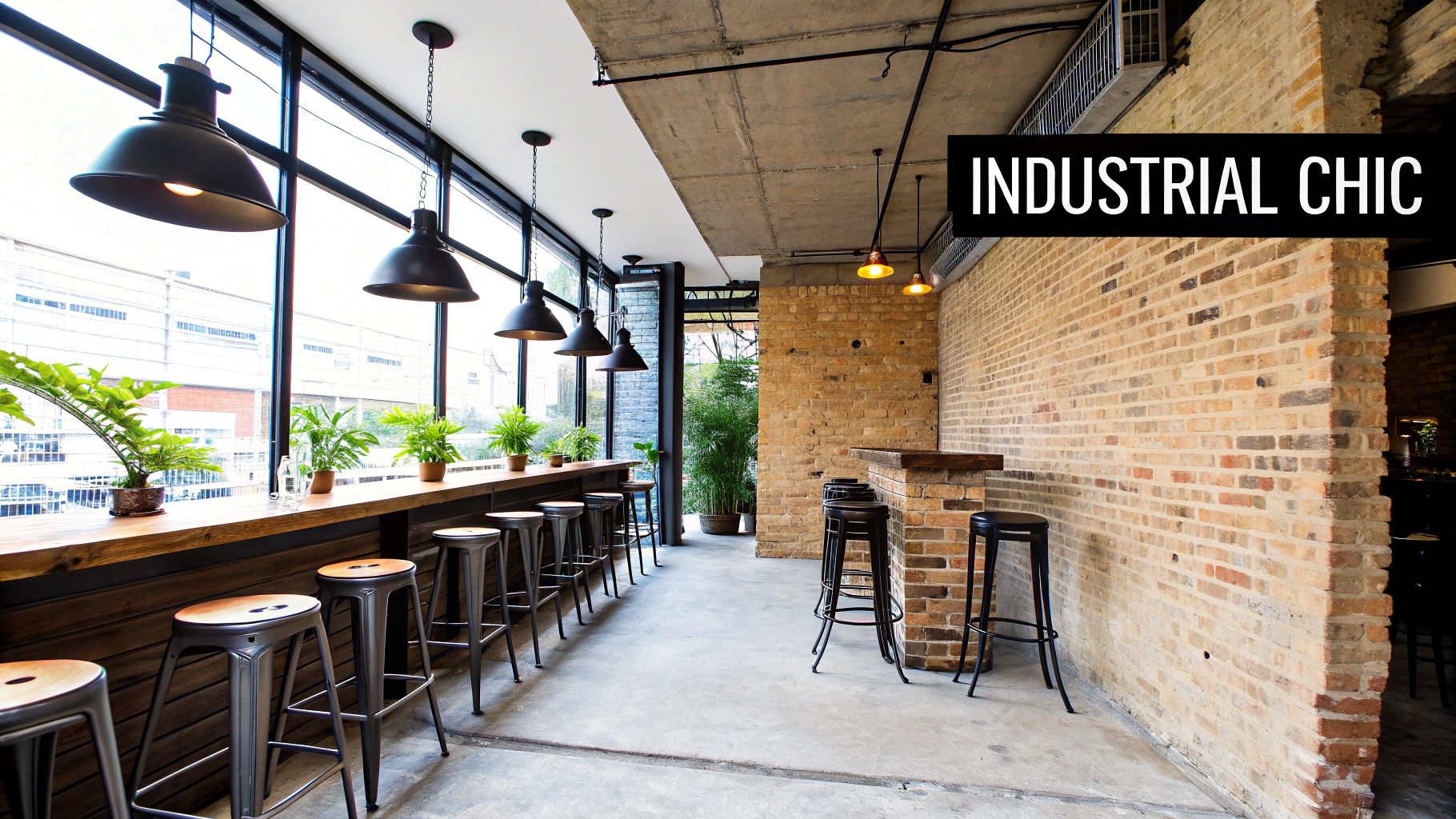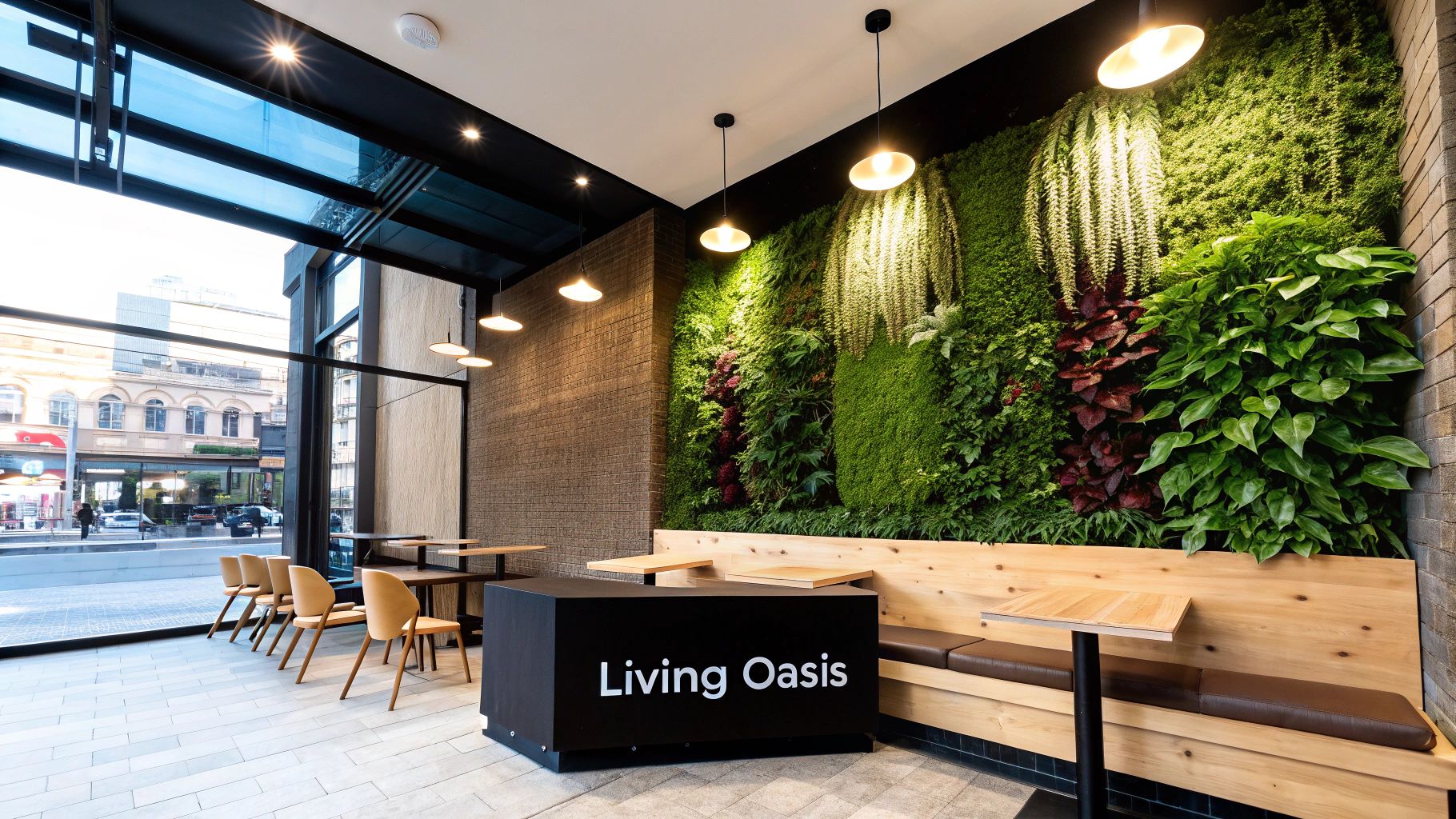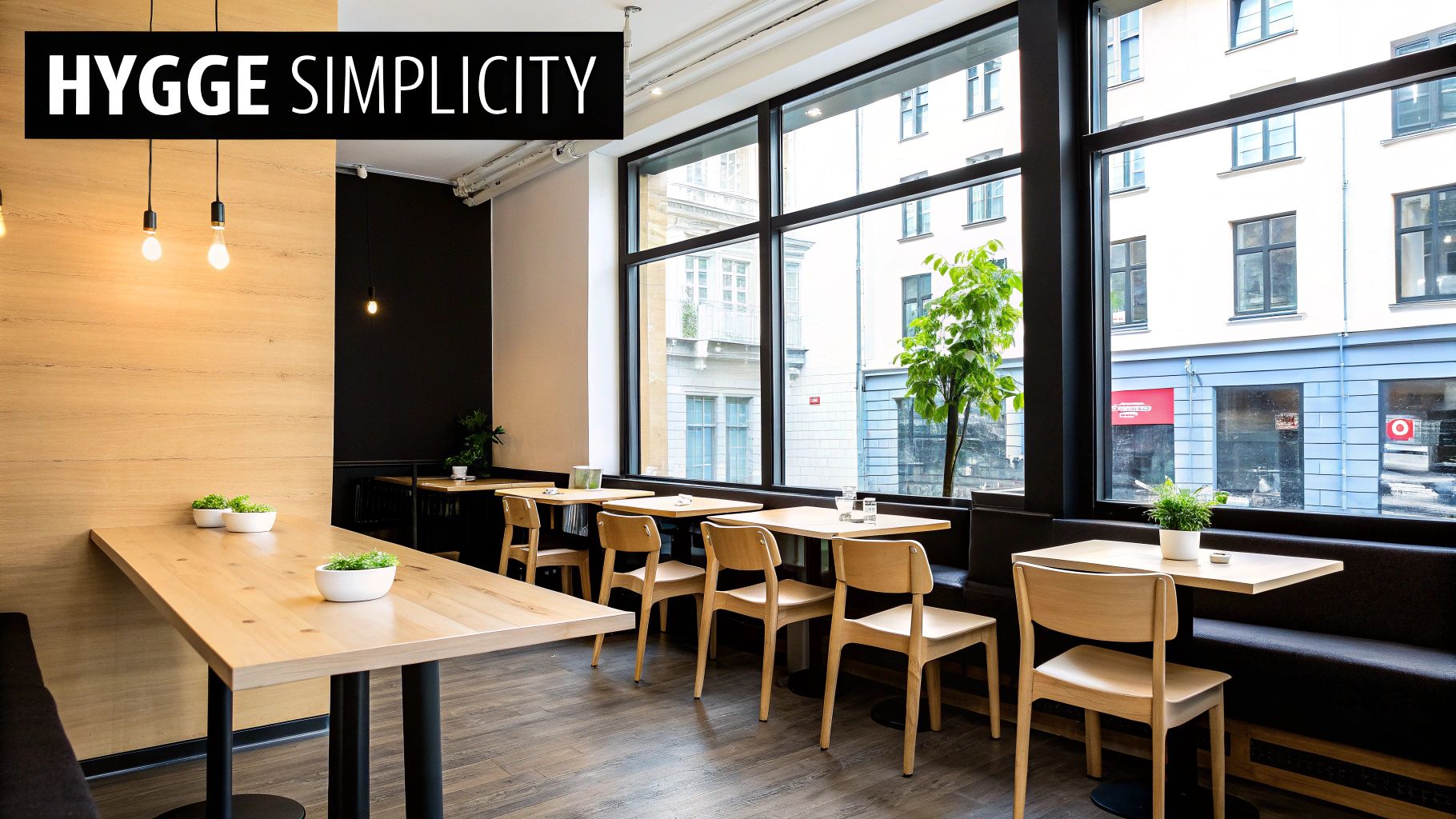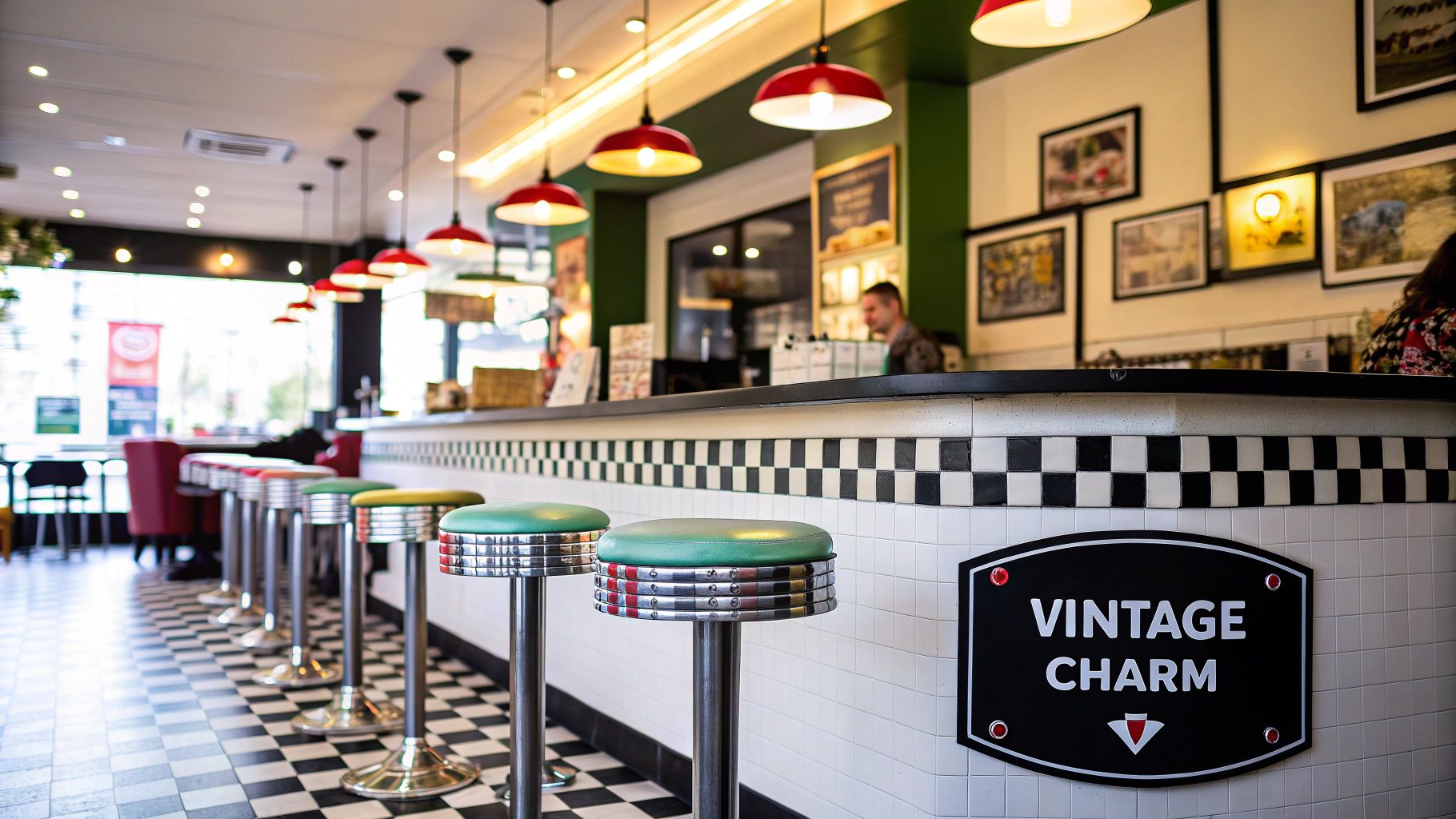9 Cafe Interior Design Ideas to Inspire Your Space in 2025

The aroma of freshly ground coffee beans is only part of the story. A truly successful cafe creates an experience, an ambiance that invites customers to stay, connect, and return. The right interior design is not just about aesthetics; it's a powerful business tool that shapes customer perception, dictates foot traffic, and builds a loyal community. In New Zealand's competitive cafe scene, a thoughtfully designed space can be your most significant differentiator.
This guide moves beyond generic advice to explore nine distinct and actionable cafe interior design ideas. We will provide detailed blueprints to help you craft a unique, functional, and unforgettable environment that resonates with your brand and attracts your ideal clientele. You will learn how to implement specific styles, from the raw textures of Industrial Chic to the clean, calming lines of Scandinavian minimalism. We cover practical solutions like creating versatile spaces with modular furniture and managing acoustics for a comfortable atmosphere.
Whether you are an architect, a commercial developer, or a cafe owner planning your next fit-out, this comprehensive roundup offers the inspiration and practical steps needed to turn your vision into a reality. From incorporating living green walls to showcasing local art, these concepts are designed to ensure your cafe is not just a place for coffee, but a destination in its own right. We'll delve into layouts that enhance workflow, like open kitchen concepts, and strategies for creating distinct zones that cater to different customer needs, ensuring every square metre of your space is optimised for both experience and efficiency.
1. Industrial Chic Design
Industrial chic design channels an urban, warehouse-like aesthetic by celebrating raw, utilitarian materials. This style strips back the layers, exposing structural elements like brick walls, concrete floors, steel beams, and visible ductwork. The appeal lies in its honest, unpretentious nature, creating a space that feels both robust and effortlessly cool. This is one of the most enduring cafe interior design ideas because it offers a versatile canvas that can be adapted to feel edgy, sophisticated, or cosy.
The core of this style involves transforming industrial functionality into a design statement. Think of the pioneering spaces of Stumptown Coffee Roasters or the minimalist polish of Blue Bottle Coffee, both of which have mastered this look. It’s a design language that speaks of authenticity and craftsmanship, making it an excellent fit for cafes that pride themselves on artisanal products. By leaving materials in their natural state, you create a backdrop that is rich with texture and history.

How to Implement Industrial Chic Design
Achieving a balanced industrial look requires a thoughtful approach to prevent the space from feeling cold or uninviting. The key is to harmonise rugged elements with softer, more refined touches.
- Soften the Edges: Counteract the harshness of metal and concrete with strategic warmth. Use warm-toned, low-hanging pendant lights (like those popularised by designer Tom Dixon) to create intimate pools of light. Introducing soft textiles like leather upholstery, wool throws, or canvas cushions adds essential comfort and texture.
- Introduce Natural Elements: Greenery is crucial. Large potted plants like fiddle-leaf figs or monsteras can break up monolithic surfaces and infuse life into the space. The organic shapes of the leaves provide a beautiful contrast to the rigid lines of industrial architecture.
- Manage Acoustics: Hard surfaces like concrete and brick can create significant echo. Mitigate this by installing acoustic panels. Modern panels can be disguised as art, covered in fabric, or made from wood wool, integrating seamlessly into the decor while improving the auditory experience for customers.
- Balance with Vintage Finds: Mix iconic industrial pieces with vintage furniture. A set of restored wooden school chairs or a timeworn timber communal table can add character and a sense of history, preventing the design from feeling too sterile or generic.
- Climate Control: Remember that materials like concrete and exposed metal do not retain heat well. Ensure your heating system is adequate to keep the cafe comfortable, especially during colder months in New Zealand. Underfloor heating is an excellent, albeit more expensive, option for concrete floors.
2. Biophilic Design with Living Walls
Biophilic design is founded on the idea that humans have an inherent need to connect with nature. This approach brings natural elements into the built environment to create spaces that reduce stress and enhance wellbeing. In a cafe setting, this translates to using plants, natural light, organic materials, and nature-inspired shapes to craft a restorative atmosphere. A living wall, or vertical garden, often serves as the spectacular centrepiece of this design.
This concept goes beyond simply adding a few potted plants; it’s about creating an immersive, sensory experience that echoes the outdoors. Cafes like Australia's Grounds of Being or the lush Terrain Cafés have demonstrated how biophilic elements can transform a commercial space into a tranquil oasis. This is one of the most impactful cafe interior design ideas for businesses aiming to offer customers an escape from the urban hustle, creating a memorable and calming environment that encourages them to linger.

How to Implement Biophilic Design
A successful biophilic design feels integrated and intentional, not just like an afterthought. It balances the practical needs of a cafe with the aesthetic and psychological benefits of nature.
- Plan Your Greenery: A full-scale living wall is a significant investment. Start by selecting low-maintenance plants suited to your cafe’s light conditions, such as Pothos, Snake Plants, or certain ferns. For a living wall, it’s crucial to partner with a local nursery or specialist who can advise on species and ongoing care.
- Ensure Proper Infrastructure: Living walls require robust support and irrigation. A professional installation should include a waterproof backing, a lightweight growing medium, and a built-in, automated drip irrigation and drainage system to prevent water damage and simplify maintenance.
- Supplement with Lighting: Even with large windows, most indoor spaces need supplemental light for plants to thrive. Install full-spectrum LED grow lights that can be programmed to provide the right amount of light, ensuring your green wall remains vibrant and healthy year-round.
- Incorporate Other Natural Materials: Enhance the effect of your greenery by pairing it with other natural textures. Use materials like reclaimed timber for tables, stone for countertops, and bamboo for decorative screens. These elements reinforce the connection to the natural world.
- Embrace Sustainable Practices: Biophilic design aligns naturally with eco-conscious principles. Consider how your design choices can be more sustainable, from sourcing local materials to implementing water-saving systems. For more inspiration, you can find a range of sustainable interior design ideas for 2025 that complement a biophilic approach.
3. Minimalist Scandinavian Style
Minimalist Scandinavian style champions simplicity, functionality, and the Danish concept of 'hygge' – a feeling of cosiness, contentment, and well-being. This design philosophy creates calm, uncluttered spaces by using light colours, natural materials, and clean lines, all while maintaining a deep sense of warmth and approachability. This is one of the most beloved cafe interior design ideas because it offers a serene, inviting retreat from the hustle and bustle of daily life, making customers feel instantly at home.
The essence of this style is creating a bright, airy, and organised environment that feels both practical and beautiful. Think of the light-filled spaces of Sightglass Coffee or the functional elegance of Joe Coffee Company stores. It’s a design language rooted in the work of pioneers like Alvar Aalto and Arne Jacobsen, which focuses on human-centric design and a deep respect for natural materials. This aesthetic is perfect for cafes that want to project a clean, modern, and thoughtful brand image.

How to Implement Minimalist Scandinavian Style
Creating an authentic Scandinavian interior involves more than just a white and wood palette; it requires careful curation and a focus on quality over quantity. The goal is to design a space that feels intentional and peaceful.
- Prioritise Light and Space: Use a light, neutral colour palette with white, soft greys, and pale blues as your base to maximise natural light. Keep window treatments minimal; sheer curtains or blinds are ideal. Use mirrors strategically to reflect light and create an illusion of more space.
- Incorporate Natural Textures: Introduce warmth and prevent the space from feeling clinical by layering natural materials. Use light-toned woods like beech, ash, and pine for flooring, tables, and counters. Add soft textures with woollen throws, linen cushions, and leather details on seating.
- Invest in Quality Furniture: Scandinavian design values longevity and craftsmanship. Choose furniture with clean lines and simple, functional forms. Iconic pieces from brands like Fritz Hansen or replicas of Hans Wegner chairs can serve as focal points that embody the style’s ethos.
- Add Strategic Greenery: Plants are used sparingly but purposefully to add a touch of life and colour. A single monstera in a simple pot or a few small succulents on a shelf is often enough to enhance the natural, calming atmosphere without creating clutter.
- Focus on 'Hygge' Lighting: Lighting is key to achieving hygge. Use multiple light sources to create a layered, warm glow. Low-hanging pendants over tables, subtle floor lamps in corners, and candlelight (or battery-operated alternatives) create a soft, inviting ambience in the evenings.
4. Flexible Modular Furniture Systems
Flexible modular furniture systems offer a dynamic and intelligent solution for cafe owners looking to maximise their space and adapt to changing customer needs. This approach involves using individual components, such as seats, tables, and partitions, that can be easily rearranged into various configurations. It empowers a cafe to transform from a morning hub for solo remote workers to a bustling lunch spot for groups, and then into an intimate evening venue, all with minimal effort. This is one of the most practical cafe interior design ideas for modern, multi-use spaces that need to evolve throughout the day or week.
The genius of this concept lies in its blend of efficiency and customisation. Instead of a static layout, you create a fluid environment that can respond to demand in real-time. Pioneering furniture companies like Herman Miller and Vitra have long championed modularity in office design, and the concept translates perfectly to the hospitality sector. Think of the adaptable seating in a modern university library cafe or the clever reconfigurable zones in an airport lounge, designed to accommodate diverse groups and activities.

How to Implement Flexible Modular Furniture Systems
A successful modular system is more than just movable furniture; it requires a strategic plan to ensure functionality and durability. The goal is to make reconfigurations seamless for staff and intuitive for customers.
- Prioritise Lightweight, Durable Materials: Choose furniture that is easy for staff to move. Look for pieces made from lightweight materials like aluminium, moulded plastics, or engineered wood. However, do not sacrifice durability, especially in a high-traffic cafe environment. Invest in high-quality casters (wheels) and hardware that can withstand constant movement.
- Create Standard Configuration Plans: Don't leave layouts to guesswork. Develop and document a few key configurations for different scenarios, such as "Morning Rush," "Lunch Peak," and "Evening Event." Use simple diagrams or colour-coded markings on the floor to show staff exactly where pieces should go.
- Integrate Power and Data: In today's digital world, access to power is non-negotiable. Select modular seating that has integrated power outlets and USB ports. This turns your flexible zones into valuable workspaces for customers, encouraging longer stays.
- Use Modular Shelving and Partitions: Flexibility isn't just for seating. Use modular shelving systems like those from USM to create customisable retail displays or partitions. These can be used to divide a large open space into smaller, more intimate nooks or to create temporary private areas for meetings or small events.
- Balance Fixed and Flexible Elements: A completely modular space can sometimes feel unsettled. Anchor the layout with a few fixed elements, like a permanent bar, built-in banquette seating along one wall, or a large communal table. This provides a stable reference point around which the flexible components can be arranged.
5. Vintage and Retro Aesthetic
The vintage and retro aesthetic captures the charm and personality of past eras, from the optimistic energy of the 1950s to the bold eclecticism of the 1970s. This approach creates a comforting, nostalgic atmosphere by using authentic period furniture, distinctive colour palettes, and iconic decorative items. The appeal lies in its ability to tell a story and create a deeply familiar, character-rich environment that feels both unique and welcoming. This is one of the most beloved cafe interior design ideas because it offers a break from modern minimalism, inviting customers into a warm and memorable world.
At its core, this style is about curating a specific moment in time. Think of the quintessential 1950s American diner aesthetic, popularised by films like American Graffiti, or the sophisticated, old-world charm of historic coffee houses like Caffe Reggio in New York. The design language speaks of history, homeliness, and a slower pace of life, making it a perfect match for cafes that aim to be a community hub or a cosy escape. By carefully selecting pieces from a specific decade, you can craft a cohesive and immersive customer experience.

How to Implement a Vintage and Retro Aesthetic
Creating a successful retro space means balancing nostalgia with modern functionality to avoid a cluttered or dated feel. The key is to commit to a specific era and blend authentic pieces with reliable contemporary elements.
- Focus on a Decade: Choose a specific period, like the mid-century modern '60s or the earthy tones of the '70s, to guide your choices in colour, furniture, and patterns. This focus ensures a cohesive design rather than a chaotic mix of styles. Use avocado green, mustard yellow, and orange for a '70s vibe, or turquoise and cherry red for a '50s diner look.
- Mix Authentic and Inspired Pieces: Sourcing authentic vintage furniture can be costly and challenging. Balance key statement pieces, like a restored vinyl booth or a set of genuine Eames chairs, with high-quality retro-inspired reproductions. This approach ensures durability and functionality while maintaining the desired aesthetic.
- Embrace Textures and Patterns: Retro design is rich with texture and pattern. Incorporate vinyl upholstery, shag pile rugs, dark wood panelling, or bold geometric wallpapers. These elements are crucial for creating an authentic, multi-layered environment that engages the senses.
- Curate Your Decor: The details make the design. Source period-appropriate decor like vintage posters, old-school Coca-Cola signs, rotary phones, or lava lamps. Lighting is also critical; look for globe pendants, Sputnik chandeliers, or mushroom-shaped table lamps to complete the look.
- Ensure Modern-Day Compliance: While a vintage espresso machine might look fantastic, it must meet current health and safety standards in New Zealand. Prioritise modern, reliable equipment for your kitchen and service areas, keeping the retro theme for furniture, lighting, and customer-facing decor. This ensures your cafe is both stylish and operationally sound.
6. Open Kitchen and Coffee Bar Design
An open kitchen and coffee bar design dismantles the traditional barriers between staff and customers, transforming the preparation process into a captivating performance. This approach fosters a sense of transparency and trust, inviting patrons to witness the skill and care that goes into their order. By making the barista’s craft visible, you create an engaging, educational experience that elevates the simple act of buying a coffee into a memorable event. This is one of the most powerful cafe interior design ideas for building a community and showcasing a commitment to quality.
The concept turns the operational heart of the cafe into its main attraction. Third-wave coffee pioneers like Stumptown Coffee Roasters and Intelligentsia have championed this design, creating brew bars where customers can interact with baristas and learn about different brewing methods. This layout speaks volumes about a cafe’s confidence in its products and processes, making it a perfect fit for specialty roasters and artisanal bakeries who want their craftsmanship to be the hero of the space.

How to Implement an Open Kitchen and Coffee Bar Design
A successful open-concept design requires meticulous planning to ensure it remains organised, clean, and efficient, rather than chaotic. The goal is to blend theatricality with flawless functionality.
- Invest in Aesthetics and Function: Your equipment is now part of the decor. Invest in professional-grade machines with a strong design presence, like a sleek La Marzocco espresso machine or elegant pour-over stands. Ensure these pieces are not only beautiful but also ergonomic for your staff.
- Prioritise Cleanliness and Organisation: With everything on display, tidiness is non-negotiable. Train staff rigorously to maintain immaculate work surfaces. Maximise under-counter storage for supplies and less attractive items to keep the main bar clutter-free. Integrated "knock boxes" and rinsing stations help maintain a clean workflow.
- Manage Sensory Overload: An open kitchen generates noise, steam, and odours. Install a high-quality, quiet ventilation and extraction system to manage cooking smells and steam effectively. Consider the acoustics by using sound-absorbing materials in the ceiling or on walls to prevent the space from becoming overwhelmingly loud.
- Create Designated Zones: Organise the bar into clear functional zones. A dedicated area for espresso-based drinks, another for pour-over or filter coffee, and a separate point for payment and pickup will streamline service and guide customer flow. This prevents bottlenecks and keeps the operational theatre running smoothly.
- Use Strategic Lighting: Use lighting to highlight the action. Position spotlights or focused pendants directly over the primary work areas, such as the espresso machine and brew station. This not only aids staff but also draws the customer’s eye, framing the preparation process like a stage performance.
7. Multi-Zone Layout Design
Multi-zone layout design strategically divides a cafe into distinct areas, each tailored to different customer activities and preferences. This approach moves beyond a uniform seating plan, creating dedicated zones for quiet work, social gatherings, quick takeaways, and relaxed lounging. By catering to a diverse clientele, from solo remote workers to large groups, you maximise the functionality and appeal of your space. This is one of the most intelligent cafe interior design ideas as it enhances customer experience by providing the right environment for every need.
The core principle is to create a dynamic and adaptable space that feels like multiple venues in one. Think of the deliberate zoning in large Starbucks Reserve locations, which seamlessly guide customers between a fast-paced coffee bar, intimate seating nooks, and collaborative tables. This design philosophy acknowledges that a single customer might use the cafe for different purposes on different days, making the space more versatile and increasing repeat business. It’s a design that boosts both customer satisfaction and operational efficiency.

How to Implement Multi-Zone Layout Design
Creating effective zones requires more than just different furniture; it involves a holistic approach to design that considers acoustics, lighting, and traffic flow. The goal is to create clear distinctions without building solid walls.
- Define Zones with Furniture and Lighting: Use furniture arrangements to signal each zone's purpose. Bar-height counters and stools are ideal for quick visits, while low-slung armchairs and sofas create a comfortable lounge. Use lighting to reinforce the mood: bright, focused lighting in work areas and warm, ambient pendant lights in social spaces.
- Use Subtle Dividers: Create visual separation without sacrificing an open feel. Low bookcases, large potted plants, or elegant folding screen room dividers can effectively delineate zones. Changing floor materials, like transitioning from concrete to a timber-look LVT, can also subtly mark a new area.
- Manage Acoustics: A common challenge is noise spillover between zones. Position quiet work areas away from high-traffic spots like the counter and entrance. Use soft furnishings, acoustic wall panels, or even strategically placed rugs to absorb sound and maintain a peaceful atmosphere in designated quiet zones.
- Consider Power and Connectivity: For work-focused zones, ensure ample and easily accessible power outlets and USB ports. Strong, reliable Wi-Fi is a given. Placing these amenities thoughtfully encourages longer stays from customers looking for a place to work or study.
- Establish Clear Traffic Flow: Plan clear pathways between zones to avoid congestion and disruption. The layout should intuitively guide customers from the entrance to the counter and then to their chosen zone without creating bottlenecks or forcing them to cut through quiet areas.
8. Local Art and Community Gallery Walls
Incorporating local art transforms a cafe from a simple place for coffee into a vibrant community cultural hub. This design strategy involves dedicating wall space to a rotating gallery of works by local artists, creating an environment that is constantly evolving and visually engaging. The appeal lies in its ability to build deep community connections, support the local arts scene, and offer an affordable, dynamic decor solution. This is one of the most impactful cafe interior design ideas for fostering a loyal customer base that values culture and local talent.
This approach turns your cafe's walls into a living canvas. It's a concept mastered by countless independent coffee shops worldwide, which become known as much for their creative atmosphere as for their coffee. By providing a platform for artists, you create a space that feels authentic, community-focused, and unique. It tells a story of local pride and collaboration, making your cafe a destination rather than just a stop-over. This dynamic decor ensures regular customers always have something new to appreciate.
How to Implement Local Art and Community Gallery Walls
Creating a successful gallery wall requires more than just hanging a few pictures. A well-organised system ensures the space looks professional and benefits both your cafe and the artists.
- Establish Clear Agreements: Formalise your partnership with artists. Create a simple contract outlining the display duration, responsibility for any damage, and the commission structure if art is sold (a 15-25% commission is common). This clarity prevents misunderstandings and builds professional relationships.
- Use Professional Hanging Systems: Invest in a gallery track hanging system. These systems consist of a rail installed near the ceiling with adjustable cables and hooks. They allow you to change artwork easily without damaging the walls, giving you flexibility for rotating exhibitions.
- Host Opening Receptions: Launch each new exhibition with an artist reception or "gallery night." These events generate buzz, attract new customers, and provide a wonderful opportunity for the community to engage directly with the artists. Offer a special on drinks or nibbles to enhance the festive atmosphere.
- Promote Your Artists: Use your social media channels to spotlight the featured artists and their work. Post photos of the art, share artist bios, and announce exhibition dates. This cross-promotion benefits everyone and reinforces your cafe's role as a community supporter. For those considering a more hands-on approach, you can also explore some DIY wall art ideas to supplement the gallery.
- Proper Lighting is Key: Ensure the art is well-lit. Use adjustable track lighting with spotlights directed at each piece. This not only showcases the art professionally but also contributes to the overall ambiance of your cafe, drawing attention to your curated walls.
9. Acoustic Design and Sound Management
Acoustic design is the often-overlooked secret to creating a genuinely comfortable and functional cafe. It focuses on deliberately managing the soundscape to control noise levels, minimise echo, and ensure a pleasant auditory experience. This goes beyond simply playing background music; it involves the strategic use of materials, layout, and technology to craft an environment where conversations can happen without shouting and the clatter of a busy service fades into a pleasant hum. For this reason, it is one of the most critical cafe interior design ideas for ensuring customer satisfaction and encouraging longer stays.
The importance of sound management is evident in spaces where concentration is key, such as high-end hotel lobby cafes or coworking spaces with integrated cafes. A well-designed acoustic environment feels calmer and more premium, communicating a level of care and sophistication. By controlling harsh reverberations from coffee grinders, steaming wands, and hard surfaces, you create a sanctuary that stands out from the noisy competition, making your cafe a destination for both social gatherings and focused work.
How to Implement Acoustic Design
Effective sound management is about creating a balance between absorption and reflection. The goal isn't silence but a controlled, comfortable level of ambient sound that contributes positively to the atmosphere.
- Mix Hard and Soft Surfaces: The foundation of good acoustics is material diversity. While hard surfaces like concrete floors and tiled walls are durable and easy to clean, they reflect sound, creating echo. Balance them with soft, sound-absorbing materials like upholstered banquettes, thick curtains, plush rugs, and fabric-covered chairs.
- Use Decorative Acoustic Panels: Modern acoustic panels are no longer purely functional. They can be a central feature of your decor, available in various shapes, colours, and textures. Consider panels that look like felt art, moss walls, or custom-printed canvases to absorb sound while enhancing your cafe's aesthetic. You can find out more about how the use of different materials can help to create a productive atmosphere here.
- Create Designated Quiet Zones: If space allows, create a 'quiet zone' away from the high-traffic service counter and entrance. Use partitions, bookshelves, or even large plants to visually and acoustically separate this area, making it ideal for customers looking to work or read.
- Test and Adjust: Acoustics change based on how many people are in the space. Test the sound levels during your busiest and quietest periods. This will help you identify problem areas and determine where additional sound-dampening measures might be needed. Also, train your staff to adjust music volume appropriately throughout the day.
Cafe Interior Design Ideas Comparison Matrix
| Design Style | Implementation Complexity 🔄 | Resource Requirements ⚡ | Expected Outcomes 📊 | Ideal Use Cases 💡 | Key Advantages ⭐ |
|---|---|---|---|---|---|
| Industrial Chic Design | Moderate - exposed elements easy to integrate but requires attention to detail | Low to Moderate - uses cost-effective raw materials | Stylish, urban atmosphere; Instagram-worthy; durable | Urban cafes appealing to millennials & Gen Z | Cost-effective; durable; flexible style |
| Biophilic Design with Living Walls | High - requires irrigation, lighting & maintenance systems | High - plant care, irrigation, specialized lighting | Improved air quality, wellbeing, memorable experience | Eco-conscious cafes aiming for wellness branding | Enhances air quality; unique atmosphere |
| Minimalist Scandinavian Style | Moderate - requires disciplined execution for clutter-free look | Moderate - quality natural materials, lighting | Calm, timeless, cozy yet uncluttered spaces | Cafes targeting tranquility-seeking customers | Timeless; cost-effective; calming environment |
| Flexible Modular Furniture | Moderate to High - needs staff training and quality hardware | Moderate - modular, durable furniture needed | Adaptable, maximizes space, supports events | Multi-use spaces needing layout flexibility | Maximizes space use; versatile; cost-effective |
| Vintage and Retro Aesthetic | Moderate to High - sourcing & integrating authentic vintage pieces | Moderate to High - might involve costly vintage finds | Unique nostalgic atmosphere; memorable character | Cafes targeting nostalgia lovers and collectors | Strong character; conversation starter |
| Open Kitchen and Coffee Bar | High - requires clean, organized layout & skilled staff | Moderate to High - professional equipment and ventilation | Engaging, educational experience; builds trust | Specialty coffee shops showcasing craftsmanship | Builds trust; customer engagement; efficient use |
| Multi-Zone Layout Design | High - complex planning for zones & flow | High - varied furniture, lighting, acoustics | Accommodates diverse needs; increases dwell time | Larger cafes with varied customer activities | Accommodates diversity; maximizes revenue |
| Local Art and Community Walls | Low to Moderate - ongoing curation and management | Low to Moderate - hanging systems, artist coordination | Dynamic atmosphere; community engagement | Community-focused cafes supporting local artists | Builds connections; generates additional income |
| Acoustic Design and Sound Management | High - may need professional consultation & ongoing maintenance | Moderate to High - materials and sound systems | Improved comfort; controlled noise; better atmosphere | Cafes prioritizing comfort and productivity | Enhances comfort; reduces noise complaints |
Bringing Your Vision to Life: Your Next Steps
We've journeyed through a diverse landscape of cafe interior design ideas, from the raw, textural appeal of Industrial Chic to the serene, nature-infused principles of Biophilic Design. We've explored the clean lines of Minimalist Scandinavian Style, the dynamic potential of Flexible Modular Furniture, and the nostalgic charm of a Vintage and Retro Aesthetic. Each of these concepts offers more than just a visual theme; they provide a framework for creating an immersive and memorable customer experience.
The key takeaway is that a successful cafe interior is never accidental. It's a deliberate and thoughtful fusion of brand identity, customer psychology, and functional design. The most impactful spaces are those that tell a cohesive story, where every element, from the layout to the lighting, works in harmony. Whether you're captivated by the transparency of an Open Kitchen and Coffee Bar or the community spirit of a Local Art Gallery Wall, your chosen direction must be executed with precision and a clear understanding of its purpose.
Synthesising Ideas into a Cohesive Concept
The true magic happens when you begin to synthesise these elements. The most compelling cafe interior design ideas often don't exist in a vacuum. A Scandinavian-inspired space can be dramatically enhanced with a biophilic living wall, adding warmth and organic texture to its minimalist foundation. Similarly, an industrial venue can be softened and made more inviting with strategic Acoustic Design and a well-planned Multi-Zone Layout that caters to different customer needs, from quiet solo work to lively group conversations.
Think of the concepts we've discussed as a palette of colours. Your task now is to select the right shades and blend them to create a masterpiece that is uniquely yours. Start by defining the core feeling you want your cafe to evoke. Is it a high-energy, creative hub? A tranquil, restorative escape? A nostalgic home-away-from-home? Your answer to this question will guide every subsequent decision.
Key Insight: The most memorable cafes are not slavish copies of a single trend. They are a curated blend of styles, materials, and layouts that reflect a unique brand story and cater specifically to their target clientele.
Your Actionable Blueprint for Success
Translating inspiration into reality requires a structured approach. Here are the practical next steps to bring your vision to life:
- Define Your Brand Identity: Before selecting a single piece of furniture, clarify your brand's mission, values, and personality. Your interior design should be a physical manifestation of this identity.
- Analyse Your Space and Audience: Conduct a thorough analysis of your physical location, including its architectural features, natural light, and spatial limitations. Simultaneously, define your target customer. Who are they, and what are their needs? This will inform your layout, furniture choices, and overall atmosphere.
- Create a Mood Board and Floor Plan: This is a crucial step. Gather images, material samples, and colour swatches that align with your chosen aesthetic. Develop a detailed floor plan that maps out customer flow, seating zones, and operational areas, incorporating principles like the Multi-Zone Layout.
- Prioritise Key Investments: Identify the high-impact elements that will define your space. This could be a stunning living wall, a custom-built coffee bar, unique lighting fixtures, or bespoke textiles. Allocate your budget to these features first.
- Engage with Local Talent: For elements like a community art wall, connect with local Aotearoa artists. For custom furnishings and fit-outs, seek out skilled local craftspeople. This not only ensures quality but also deepens your cafe's connection to the community.
Mastering these cafe interior design ideas is about more than just aesthetics; it's about building a sustainable and beloved business. A well-designed interior directly influences customer satisfaction, encourages longer stays, promotes social sharing, and ultimately drives loyalty. It transforms your cafe from a simple place to buy coffee into a destination, a third place where community and connection can flourish. Your space is your silent brand ambassador, working tirelessly to tell your story and create a lasting impression.
Ready to infuse your cafe with a touch of local, sustainable artistry? Maak Home specialises in creating bespoke, on-demand textiles and wallpapers right here in New Zealand, allowing you to design unique cushions, curtains, and feature walls that perfectly capture your brand's essence. Explore their customisation options to bring your unique cafe interior design ideas to life at Maak Home.









